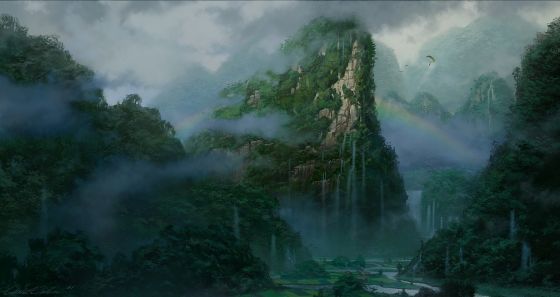Difference between revisions of "Jungle (range)"
Tao alexis (talk | contribs) (Created page with "'''Jungle''', also sometimes described as '''tropical rainforest''', describes an area of forest vegetation with a dense and tangled undergrowth that is impassable without cut...") |
Tao alexis (talk | contribs) |
||
| Line 1: | Line 1: | ||
| + | [[File:Jungle.jpg|right|560px]] | ||
'''Jungle''', also sometimes described as '''tropical rainforest''', describes an area of forest vegetation with a dense and tangled undergrowth that is impassable without cutting. Jungles are distince from sub-tropical [[Rainforest (range)|rainforest]], in that the understory of the latter is typically open of vegetation, and relatively easy to traverse. Jungles form in low-lying areas with many streams, which enable light to reach the ground, spawning undergrowth, and upon the margins of rainforests, once again due to the greater available light at ground level. | '''Jungle''', also sometimes described as '''tropical rainforest''', describes an area of forest vegetation with a dense and tangled undergrowth that is impassable without cutting. Jungles are distince from sub-tropical [[Rainforest (range)|rainforest]], in that the understory of the latter is typically open of vegetation, and relatively easy to traverse. Jungles form in low-lying areas with many streams, which enable light to reach the ground, spawning undergrowth, and upon the margins of rainforests, once again due to the greater available light at ground level. | ||
Revision as of 15:52, 17 September 2020
Jungle, also sometimes described as tropical rainforest, describes an area of forest vegetation with a dense and tangled undergrowth that is impassable without cutting. Jungles are distince from sub-tropical rainforest, in that the understory of the latter is typically open of vegetation, and relatively easy to traverse. Jungles form in low-lying areas with many streams, which enable light to reach the ground, spawning undergrowth, and upon the margins of rainforests, once again due to the greater available light at ground level.
Jungles are among the most inaccessible places on earth, with extensive parts that are untamed and isolated from civilisation. These regions experience no dry season, so that all months of the year receive a monthly rainfall of at least 4 in., and usually much more. The jungle floor consists of decaying plant and animal matter and is overrun with insects. Vast areas consist of waterlogged lowlands, or flooded forests, with the water table just inches below the surface or inundating the land, such as with mangrove swamps, which occur alongside saltwater coastlines. In high altitudes, cloud forests are characterized by persistent, frequent or seasonal low-cloud cover.
In localized areas, typically with access to the water, indigenous peoples live as hunter-gatherers, trading high-value forest products such as hides, feathers, honey and hardwoods. Agriculturalists depend upon slash-and-burn techniques, or shifting cultivation, in order to temporarily provide soils that will grow crops. Many plantation crops have been transplanted from naturally growing jungle plants, such as yams, coffee, chocolate, bananas, mangoes, papayas, macadamia, avocado and sugarcane.
Major Jungles
Below is a list of the most extensive jungles in the world:
- Amazon - enormous region covering northern South America
- Central America - from south of the Yucatan to Panama
- Choco-Darien - a moist forest west of the Columbian Andes
- Congolese - a broad belt of forest in Central Africa
- East Indies - peat swamps predominating throughout the archipelago
- Guinean - stretching from the Gold Coast to Senegal
- Indochinese - extensive area surrounding Burma, Siam and southern China
- Pacific Islands - located throughout the tropical Pacific
- Tamil - Ceylon and southern India
Common Features
Below is a list of elements and features that are common to jungle ranges:
